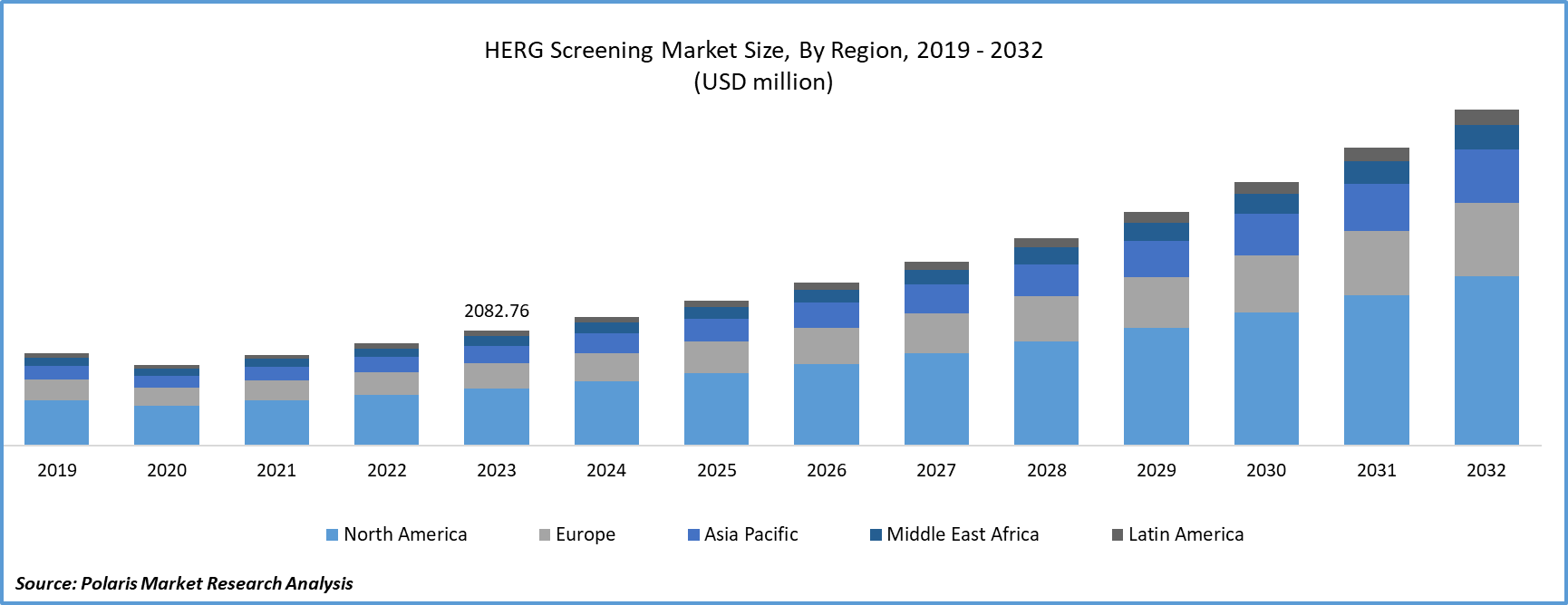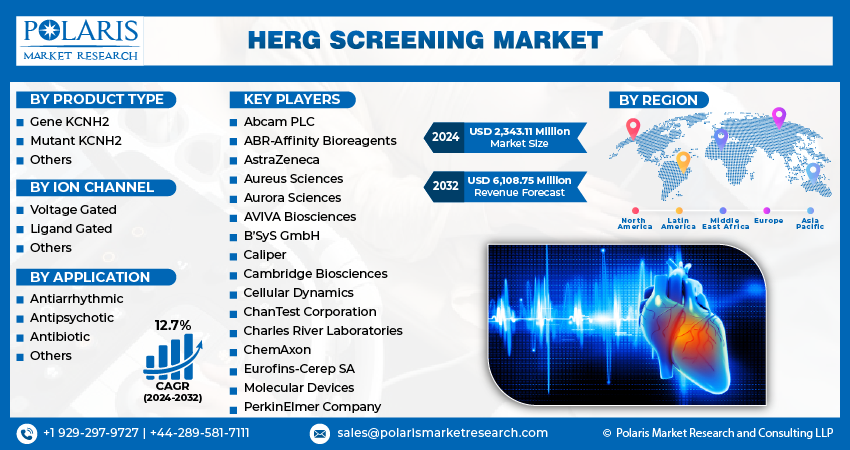
HERG Screening Market Share, Size, Trends, Industry Analysis Report, By Product Type (Gene KCNH2, Mutant KCNH2, Others); By Ion Channel; By Application; By Region; Segment Forecast, 2024 - 2032
- Published Date:Dec-2023
- Pages: 119
- Format: PDF
- Report ID: PM4144
- Base Year: 2023
- Historical Data: 2019-2022
Report Outlook
The global HERG screening market was valued at USD 2,082.76 million in 2023 and is expected to grow at a CAGR of 12.7% during the forecast period.
hERG stands for human Ether-a-go-go-Related Growth. Gene has made advantage of his contribution to cardiac activity. Its channels assist the heart beat by moderating repolarizing current in the cardiac action potential. It encodes the protein Kv11.1, which functions as the alpha subunit of a potassium ion channel. Before the filing of an experimental new medication, regulatory authorities have made hERG evaluations a priority requirement. Manual/automatic patch-clamp test, hERG radioligand binding assay, fluorescence polarization assay, and microelectrode array are some of the hERG screening assays.

To Understand More About this Research: Request a Free Sample Report
The HERG screening market is being driven by the increasing number of innovative medication approvals and the rising prevalence of cardiac disorders. However, the high cost of hERG screening tools is projected to stifle market growth throughout the projection period. Nonetheless, unexplored markets are anticipated to create a lucrative potential for this market's growth in the near future.
The primary application of hERG screening is in the drug discovery process. In the next years, the rising number of product releases is expected to drive up demand for hERG screening. The rising number of innovative medication approvals is projected to promote the drug discovery process, which will aid in the growth of the market.
The automated patch-clamp test measures hERG current at various doses. It is carried out both before and after exposure to test chemicals. The IC50 values are then established using a procedure known as dosage formulation analysis. Similarly, the other tests are carried out in accordance with their respective standards. hERG screening provides several advantages, including the existence of a channel that serves as a target for class III antiarrhythmic medicines such as amiodarone. It increases the action potential while decreasing the danger of re-entrant arrhythmias. It can be utilized as a diagnostic marker in the treatment of disorders such as cancer, recurring epileptic seizures, and schizophrenia.

For Specific Research Requirements, Request for a Customized Research Report
Growth Drivers
- Increasing prevalence of cardiovascular disease
The growing acceptance of innovative medications and the increasing prevalence of heart diseases are driving the global market. In any event, unknown company areas are likely to provide a profitable opportunity for the market's development in the near future. HERG screening is mostly used for medication disclosure purposes. The growing number of item deliveries is expected to fuel demand in hERG screening in the future years. According to the Center for Drug Evaluation and Research (CDER) annual report, an estimated 25 drugs received new medication endorsement for promotion in 2016, while only 59 did so in 2018. The increasing number of new drug endorsements is required to aid the medication disclosure measure that aids the development of the hERG screening company sector.
Report Segmentation
The market is primarily segmented based on product type, ion channel, application, and region.
|
By Product Type |
By Ion Channel |
By Application |
By Region |
|
|
|
|
To Understand the Scope of this Report: Speak to Analyst
By Product Type Analysis
KCNH2 gene segment accounted for the largest revenue share over the study period. KCNH2 gene is part of a wide family of genes that code for potassium channel instructions. These channels, which carry positively charged potassium atoms (ions) out of cells, are critical to a cell's capacity to create and send electrical impulses. A potassium channel's unique function is determined by its protein components and location in the body. Channels consisting of KCNH2 proteins function in heart muscle. They are responsible for re-charging the cardiac muscle after each beating in order to keep the rhythm consistent. In the brain and spinal cord, KCNH2 protein is also generated by nerve cells and some immune cells (microglia) (central nervous system).
A KCNH2 mutation causes the cardiac arrhythmia. Also, long QT syndrome is caused by the mutation in KCNH2 gene, and an estimated 1 in 5,000 to 10,000 persons worldwide suffer from the long QT syndrome. Some of these mutations alter single protein building blocks in the protein, while others remove several amino acids. These modifications either prohibit the protein from gathering into ion channels or to modify the function of the channels. As a result, the channels are unable to control the flow of potassium ions in heart muscle cells adequately. Reduced ion transport changes electrical signal transmission in the heart, increasing the likelihood of an irregular heartbeat, which can result in fainting.
By Ion Channel Analysis
In 2023, Voltage gated ion channels dominated the market. They comprise another huge group, with each member having a distinct ion selectivity and voltage dependency. Many are also time-dependent, which means they do not respond to a voltage change instantly, but rather after a delay. Voltage-gated channels are required for action potential generation and propagation.
Over the projection period ligand gated channel expected to register the highest growth. Ligand-gated ion channels are the gated channels whose permeability increases dramatically when a chemical ligand attaches to the protein structure. The fastest-growing sector is ion gated channels. A vast subset operates as neuro-transmitter receptors, as they are found at postsynaptic locations and are activated by a chemical ligand produced by the pre-synaptic axons. Ligand channels are triggered by ligands that emerge in the extracellular space or by intracellular contacts.
By Application Analysis
The antiarrhythmic medication application sector is expected to account for a sizable market share. The growing need for medication modification ion channel activity for use in cardiovascular illnesses, metabolic disorders, and cancer is propelling the market forward. Amiodarone, a class III medication, inhibits HERG channels in both the closed and open states, and clinical evidence clearly suggest that it is a highly safe and effective antiarrhythmic medicine. It is likely that further therapy with -blocking medications, or intrinsic -blocking action of the medicines, is required to prevent proarrhythmias in a manner that is currently unclear. Similarly, the added HERG blocking action of amiodarone or carvedilol may result in greater clinical outcomes as compared to traditional treatment with pure -blocking drugs.
High levels of the macrolide antibiotics erythromycin and clarithromycin in the blood inhibit the IKr current and affect the cardiac repolarization process. Furthermore, they can inhibit CYP3A4, increasing the risk of using other torsadogenic drugs. Fluoroquinolonic antibiotics such as sparfloxacin and grepafloxacin can also cause QT prolongation and torsade de pointes. The use of high amounts of psychoactive drugs, either first or second generation, has been linked to changes in cardiac repolarization and instances of torsade de pointes.
Regional Insights
In 2023, North America accounted for the largest revenue share of the global market. This share can be contributed to technological advancement and the region’s high frequency of cardiac complaint. According to the American College of Cardiology, an estimated 356,461 Americans failed from out of sanitarium cardiac arrest in 2017, also, increased new medicine launches will prop request growth. According to the center for medicine evaluation and exploration periodic report, an estimated 25 medicines entered new medicine blessings for marketing in 2016, with 59, in 2018.
Asia Pacific is expected to experience the rapid growth in the market due to improved reimbursement well designed policies, healthcare infrastructure, and improving economic growth, all of which will have a great positive impact on the market. The market will benefit from increased initiatives by non-profit organizations in the region.
Key market players and Competitive Insight
The market is characterized by intense competition, with established players relying on advanced technology, high-quality products, and a strong brand image to drive revenue growth. These companies employ various strategies such as research and development, mergers and acquisitions, and technological innovations to expand their product portfolios and maintain a competitive edge in the market.
Some of the major players operating in the global market include
- Abcam PLC
- ABR-Affinity Bioreagents
- AstraZeneca
- Aureus Sciences
- Aurora Sciences
- AVIVA Biosciences
- B’SyS GmbH
- Caliper
- Cambridge Biosciences
- Cellular Dynamics
- ChanTest Corporation
- Charles River Laboratories
- ChemAxon
- Eurofins-Cerep SA
- Molecular Devices
- PerkinElmer Company
Recent Developments
- In July 2017, Eurofins Scientific announced the purchase of Discover X. From target identification and lead discovery through the preclinical stage and beyond, this is a key agent in drug discovery goods and services.
- In March 2020, Charles River Laboratories will collaborate with Deciphex. They are currently collaborating to create deep learning-enabled solutions to aid with rapid pathology analyses.
HERG Screening Market Report Scope
|
Report Attributes |
Details |
|
Market size value in 2024 |
USD 2,343.11 million |
|
Revenue forecast in 2032 |
USD 6,108.75 million |
|
CAGR |
12.7% from 2024 - 2032 |
|
Base year |
2023 |
|
Historical data |
2019 - 2022 |
|
Forecast period |
2024 - 2032 |
|
Quantitative units |
Revenue in USD million and CAGR from 2024 to 2032 |
|
Segments covered |
By Product Type, By Ion Channel, By Application, By Region |
|
Regional scope |
North America, Europe, Asia Pacific, Latin America; Middle East & Africa |
|
Customization |
Report customization as per your requirements with respect to countries, region and segmentation |
FAQ's
key companies in HERG screening market are Abcam PLC, PerkinElmer Company, ABR-Affinity Bioreagents, AstraZeneca, Aureus Sciences, Aurora Sciences
The global HERG screening market is expected to grow at a CAGR of 12.7% during the forecast period.
The HERG screening market report covering key segments are product type, ion channel, application, and region.
key driving factors in HERG screening market are Increasing Drug Discovery and Development
The global HERG screening market size is expected to reach USD 6.10 billion by 2032
